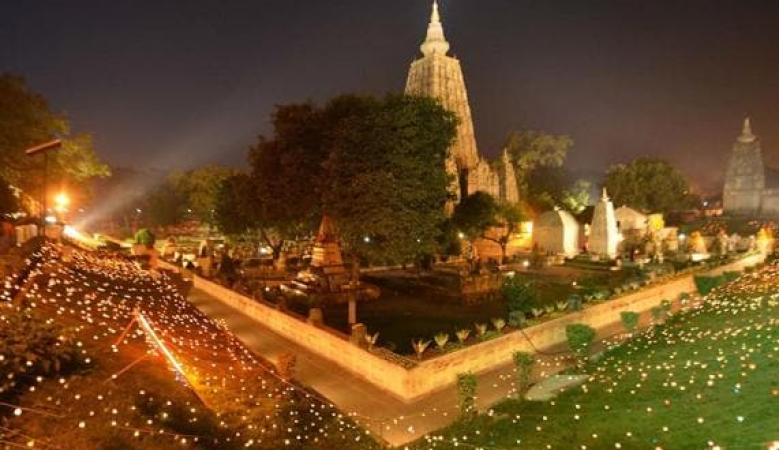
Bodh Gaya, located in the northeastern state of Bihar, India, holds immense significance for followers of Buddhism worldwide. It is believed to be the place where Gautama Buddha attained enlightenment over 2,500 years ago. Today, Bodh Gaya stands as a timeless pilgrimage site and a center for spiritual awakening. This article will delve into the rich history of Bodh Gaya and explore the must-visit attractions in this sacred land.
History of Bodh Gaya :
The history of Bodh Gaya can be traced back to the time of Prince Siddhartha Gautama, who would later become the Buddha. According to Buddhist scriptures, Prince Siddhartha meditated under the Bodhi Tree, a large sacred fig tree, for 49 days until he achieved enlightenment. The tree, known as the Bodhi Tree, still exists in Bodh Gaya and is a revered symbol for Buddhists.
After attaining enlightenment, the Buddha spent several weeks in deep contemplation at different spots in the vicinity of the Mahabodhi Temple, the most significant religious structure in Bodh Gaya. This temple was constructed by Emperor Ashoka in the 3rd century BCE and is a UNESCO World Heritage Site. The temple complex features exquisite carvings and architectural elements that reflect the influences of various dynasties that ruled over the region.
Over the centuries, Bodh Gaya continued to attract Buddhist pilgrims from all over the world. It became a vibrant center of learning and spiritual practice, with numerous monasteries and educational institutions being established. Bodh Gaya also witnessed the rise and fall of different empires, including the Mauryas, Guptas, and Pala dynasties, who all contributed to the cultural and architectural heritage of the region.
Attractions in Bodh Gaya :
Mahabodhi Temple: This iconic temple is the primary attraction in Bodh Gaya. It stands as a magnificent example of ancient Indian architecture, blending elements of Gupta, Maurya, and later dynasties. The temple complex houses the sacred Bodhi Tree and the Vajrasana, the spot where the Buddha attained enlightenment. The Mahabodhi Temple is a spiritual hub where visitors can witness monks and devotees meditating and engaging in prayer.
Bodhi Tree: The Bodhi Tree, situated within the Mahabodhi Temple complex, is considered one of the oldest living trees in the world. It is believed to be a direct descendant of the tree under which the Buddha achieved enlightenment. Visitors can walk around the tree and experience a profound sense of serenity and tranquility.
Great Buddha Statue: Standing tall at 80 feet, the Great Buddha Statue is an impressive sight in Bodh Gaya. The statue depicts the Buddha in a seated meditative posture, symbolizing enlightenment. It was unveiled by the 14th Dalai Lama in 1989 and has since become an iconic symbol of Bodh Gaya.
Thai Monastery: The Thai Monastery is a beautiful architectural gem donated by the Kingdom of Thailand. It showcases traditional Thai temple design and offers visitors a glimpse into Thai Buddhist culture. The monastery houses a stunning bronze statue of the Buddha and is an ideal place for meditation and reflection.
Japanese Temple: The Japanese Temple, also known as the Indosan Nipponji Temple, is a magnificent structure built by Japanese Buddhists. It features traditional Japanese architecture and serves as a symbol of Indo-Japanese friendship. The temple offers meditation halls and serene gardens, creating a serene atmosphere for visitors.
Tibetan Monastery: The Tibetan Monastery, also called the Tergar Monastery, is a significant center for Tibetan Buddhism in Bodh Gaya. It is known for its vibrant colors, intricate murals, and prayer wheels. Visitors can participate in meditation sessions and witness the chanting of sacred mantras.
Archaeological Museum: Located near the Mahabodhi Temple, the Archaeological Museum showcases a remarkable collection of Buddhist sculptures, artifacts, and relics dating back centuries. The museum provides valuable insights into the history and evolution of Buddhism in the region.
Bodh Gaya stands as a timeless testament to the journey of self-discovery and spiritual enlightenment undertaken by the Buddha. With its rich history, iconic landmarks, and serene atmosphere, it continues to attract pilgrims and seekers from all corners of the globe. Whether one is a follower of Buddhism or simply curious about ancient history and spirituality, Bodh Gaya offers a transformative experience that transcends cultural and religious boundaries. A visit to this sacred land leaves an indelible impression on the soul, fostering a deeper understanding of the human quest for enlightenment and inner peace.
Boryeong Mud Festival: Discovering South Korea's Celebration of Mud
Museum of Broken Relationships: Exploring Love, Loss, and Healing
The La Tomatina Festival: Exploring the Tomato-Throwing Extravaganza Held Annually in Buñol, Spain